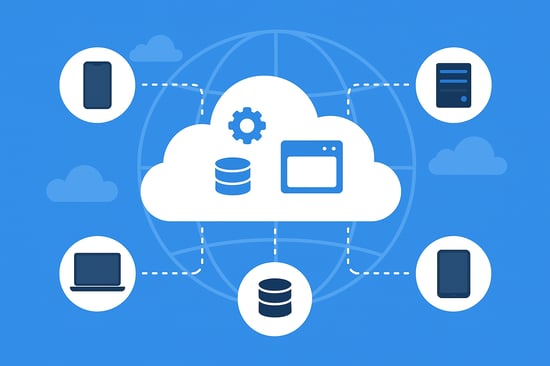How Cloud Computing Transforms Business Operations
In today’s rapidly evolving digital environment, organizations need technology that is flexible, scalable, secure, and cost-effective. Cloud computing has emerged as a game changing enabler, fundamentally transforming how enterprises and government agencies operate and deliver value. By moving operations to the cloud, organizations can streamline processes, enhance collaboration, accelerate innovation, and reduce costs while improving resilience. In fact, 94% of enterprises already use cloud services, and public cloud spending is projected to reach $723.4 billion in 2025 ¹ ². At ICM Solutions, we offer cloud consulting and services designed to help you fully realize these benefits and position your organization for the future.
What Is Cloud Computing?

Cloud computing refers to delivering computing services. This includes servers, storage, databases, networking, software, analytics, and intelligence over the internet (“the cloud”) rather than through on-premises infrastructure. This model provides on-demand access to shared IT resources that can be rapidly provisioned and released with minimal management effort.
Instead of owning and maintaining physical data centers and servers, organizations can rent computing power and storage from cloud providers on a pay as you go basis, turning capital expenditures into operational expenditures ³. This allows organizations to focus on their core missions rather than IT maintenance and large hardware investments.
Cloud services come in different forms:
Infrastructure as a Service (IaaS): Access to fundamental computing resources.
Platform as a Service (PaaS): Tools for developing, testing, and managing applications.
Software as a Service (SaaS): Complete applications delivered over the internet.
Deployment models include public, private, hybrid, and multi-cloud approaches, enabling organizations to choose the right level of control, security, and flexibility for their needs ³.
The Business Imperative for Cloud Adoption
Cloud computing is no longer just an IT modernization strategy, it’s a business and mission critical imperative. According to McKinsey, cloud adoption at scale could generate $3 trillion in EBITDA value by 2030, largely through accelerated innovation and new revenue streams ⁴. Gartner predicts that by 2025, over 51% of IT spending will have shifted from traditional solutions to the cloud ⁵.
Organizations are under pressure to deliver digital services faster, operate more efficiently, and adapt quickly to changing demands. Cloud enables these goals by supporting faster deployment, reducing time to market, and providing access to advanced technologies such as AI and analytics.
The COVID-19 pandemic further underscored the importance of cloud by forcing organizations to accelerate digital transformation and support large scale remote work ⁶. Public sector agencies, in particular, have used cloud to modernize citizen services and improve resilience.
Increased Flexibility and Scalability
Cloud computing provides unparalleled flexibility and scalability, enabling organizations to dynamically adjust resources as demand changes. Traditionally, scaling IT resources required substantial capital investments and long planning cycles. With the cloud, organizations can scale capacity up or down instantly which is critical for handling seasonal peaks, unexpected surges, or global service delivery ⁷.
A recent survey found that 62% of IT executives cited scalability and flexibility as their primary reasons for moving to the cloud ⁸. Whether it’s a government agency supporting disaster response or a bank launching a new mobile app, cloud enables rapid scale without delays or infrastructure bottlenecks.
Moreover, many organizations are adopting multi cloud or hybrid strategies, mixing public and private clouds to meet specific workload, regulatory, and risk requirements. Over 80% of enterprises currently use multiple cloud providers, reflecting the desire for maximum flexibility and to avoid vendor lock-in ⁹.
Cost Savings and Efficiency
The cloud’s pay as you go pricing model reduces or eliminates the need for large upfront capital expenditures. Instead of investing in hardware that may become obsolete or underused, organizations pay only for what they consume ¹⁰.
A study by Accenture found that migrating workloads to the public cloud can result in 30–40% total cost of ownership (TCO) savings ¹¹. Additionally, 84% of organizations report overall IT cost reductions after moving to the cloud ¹².
Beyond direct IT savings, cloud adoption brings operational efficiencies. IT staff spend less time maintaining infrastructure and more time on strategic projects. Applications and data can be consolidated, reducing redundancy and licensing fees. Moreover, organizations no longer need to over provision hardware “just in case,” avoiding the historical practice of paying for excess capacity.
However, effective cost management is essential. Approximately 30% of cloud spend is wasted due to underused or forgotten resources ¹³. Establishing robust financial operations (FinOps) practices and using native cost optimization tools can help organizations track and optimize spend.
Enhanced Collaboration and Remote Work
Cloud computing has revolutionized workplace collaboration by enabling secure, real-time access to data and applications from anywhere. Tools like Microsoft 365, Google Workspace, Slack, and Zoom have become foundational to modern digital workplaces ¹⁴.
During the pandemic, cloud solutions proved indispensable. In the U.S., 20% of workers are expected to remain in remote or hybrid roles by 2025 ¹⁵. Cloud based platforms allow distributed teams to work seamlessly, share documents in real time, and hold virtual meetings securely.
Organizations report significant benefits: 71% of business leaders cite improved employee satisfaction and productivity with hybrid and remote models ¹⁶. Beyond internal collaboration, cloud facilitates secure external partnerships, enabling organizations to engage contractors, vendors, and global partners without compromising security or productivity.
Improved Security and Backup (Resilience)
Security has historically been a concern in cloud adoption, but today, cloud providers often offer stronger security than most organizations can achieve on their own ¹⁷. Top cloud providers invest billions annually in security research and operations, employ dedicated security experts, and comply with stringent global standards ¹⁸.
Modern cloud security includes encryption at rest and in transit, advanced threat detection using AI, multi-factor authentication, and continuous monitoring. In a recent PwC survey, 60% of executives ranked enhanced security as the top benefit of cloud adoption ¹⁹.
Cloud platforms also improve disaster recovery and business continuity. Data is typically stored redundantly across geographically distributed data centers, drastically reducing the risk of permanent loss. Businesses using cloud-based disaster recovery report average recovery times of 2.1 hours, compared to 8 hours for on-premises-only environments ²⁰.
Additionally, cloud providers comply with rigorous standards like FedRAMP, HIPAA, and ISO 27001, which help organizations maintain regulatory compliance ²¹. It’s important to note that cloud security is a shared responsibility model: while providers secure the infrastructure, organizations must configure and manage applications and data responsibly ²².
Faster Innovation and Time to Market
Cloud computing significantly accelerates innovation. By offering on demand access to advanced technologies like AI, ML, big data analytics, and IoT platforms, cloud enables organizations to experiment and launch new services rapidly ²³.
McKinsey estimates that up to 75% of cloud’s business value comes from faster innovation and new capabilities rather than pure cost savings ²⁴. The ability to build, test, and deploy new applications quickly allows organizations to respond to changing user needs and market demands faster.
For example, Moderna leveraged cloud platforms to speed up COVID-19 vaccine development, enabling rapid simulation, analysis, and scaling ²⁵. In government, agencies have used cloud based analytics to improve public health responses and disaster management ²⁶.
Cloud also supports modern DevOps practices, including continuous integration and continuous deployment (CI/CD), allowing faster release cycles and iterative improvements. By reducing friction in experimentation and scaling, cloud empowers organizations to innovate boldly and continuously.
Real-World Examples and Case Studies
U.S. Federal Government
The U.S. federal government adopted cloud solutions to modernize legacy systems and improve citizen services. Initiatives like FedRAMP and Cloud Smart have driven secure migration to the cloud. For example, the Department of Veterans Affairs leveraged cloud to expand telehealth services, providing care to millions of veterans remotely ²⁷.
Capital One
Capital One embraced a cloud first strategy to improve agility and resilience. Migrating most workloads to AWS reduced data center footprint, enhanced security, and accelerated the deployment of new features. This strategic shift supported real-time analytics and allowed personalized digital banking experiences ²⁸.
NHS Digital (UK)
The UK's National Health Service used cloud platforms to track COVID-19 data and manage vaccine rollout logistics. Cloud analytics facilitated faster decision making and national level data sharing, improving operational efficiency and patient care during the pandemic ²⁹.
Why Choose ICM Solutions for Cloud Transformation?

While the advantages of cloud computing are clear, successful adoption requires expert planning and execution. Research shows two-thirds of cloud programs fail to meet expectations, often due to unclear strategies, skill gaps, and uncontrolled spending ³⁰.
ICM Solutions provides a comprehensive approach to cloud transformation tailored to your organization’s needs. Our services include:
- Strategic Roadmapping: Aligning cloud adoption with business goals and compliance requirements.
- Cost Optimization: Establishing FinOps practices to control and reduce spend.
- Security and Compliance: Implementing best practices and securing environments to meet rigorous industry and government standards.
- Innovation Enablement: Empowering teams to leverage advanced cloud-native services and modern DevOps approaches.
For instance, ICM Solutions supported a large government agency in migrating critical systems to the cloud, resulting in 25% operational cost savings, enhanced scalability, and improved uptime. Our proactive governance framework ensured continuous compliance with federal security standards.
Choosing ICM Solutions means having a trusted partner dedicated to your success at every stage from strategy and migration to ongoing optimization and innovation. We measure our success by your outcomes, whether that’s cost efficiency, faster service delivery, or improved constituent experiences.
Cloud computing is more than a technical upgrade; it is the foundation for operational transformation and sustained innovation. By moving to the cloud, organizations can become more agile, cost-effective, collaborative, secure, and innovative.
With global cloud spending projected to exceed $700 billion by 2025, and potential business value reaching trillions, the imperative to act has never been stronger ¹ ² ⁴. However, realizing this potential requires thoughtful planning and experienced guidance.
ICM Solutions stands ready to help you harness the full power of the cloud. Our expertise ensures that your cloud journey delivers tangible outcomes, improved efficiency, enhanced service delivery, cost savings, and new digital capabilities.
Ready to transform your operations with cloud? Contact ICM Solutions today to start your journey toward a more agile, resilient, and innovative future.
Sources
-
- Flexera. State of the Cloud Report 2023. Link
-
- Gartner. Forecast: Public Cloud Services, Worldwide, 2021-2027, 1Q23 Update. Link
- NIST. The NIST Definition of Cloud Computing. Link
- McKinsey & Company. Cloud’s trillion-dollar prize is up for grabs. Link
- Gartner. Gartner Forecasts Worldwide Public Cloud End-User Spending to Reach Nearly $600 Billion in 2023. Link
- Deloitte. State of Cloud in the Public Sector. Link
- Amazon Web Services. Benefits of Cloud Computing. Link
- IDG. Cloud Computing Study 2022. Link
- Flexera. State of the Cloud Report 2023. Link
- IBM. Cloud Economics: A Business Case for Cloud. Link
- Accenture. The Cloud Imperative for Business Transformation. Link
- Statista. Benefits of Cloud Computing for Organizations Worldwide 2022. Link
- FinOps Foundation. State of FinOps 2023. Link
- Microsoft. Empowering Remote Work with Microsoft 365. Link
- Pew Research Center. COVID-19 Pandemic Continues To Reshape Work in America. Link
- Gartner. Future of Work Trends Post-COVID-19. Link
- Harvard Business Review. Is the Cloud More Secure Than On-Premises?. Link
- Google Cloud. Security and Compliance. Link
- PwC. Cloud Business Survey 2023. Link
- Veeam. Data Protection Trends Report 2023. Link
- AWS. Compliance Programs. Link
- Microsoft Azure. Shared Responsibility in the Cloud. Link
- Oracle. How Cloud Accelerates Innovation. Link
- McKinsey & Company. The Cloud’s Trillion-Dollar Prize is up for Grabs. Link
- Moderna. How Moderna Used Cloud to Speed Vaccine Development. Link
- Microsoft. AI and Cloud for Public Sector Innovation. Link
- U.S. General Services Administration. Cloud Smart Strategy. Link
- Amazon Web Services. Capital One’s Journey to the Cloud. Link
- NHS Digital. COVID-19 Data Store and Dashboard. Link
- BCG. Cloud Adoption and Value Realization. Link
- Gartner. Forecast: Public Cloud Services, Worldwide, 2021-2027, 1Q23 Update. Link

